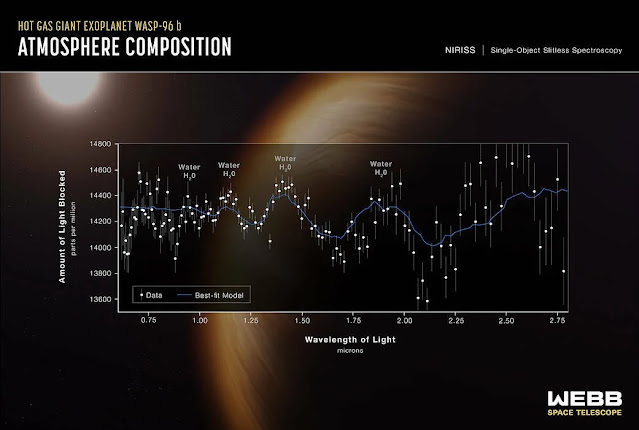- Get link
- X
- Other Apps
- Get link
- X
- Other Apps
The first color images captured by the powerful James Webb Telescope were shown to the whole globe this week for the first time.
Among the very first things that JWST discovered were galaxies, deep sections of the universe, and ebb and flow of stars. Among the deceased objects, however, was an exoplanet that could only be seen by its spectrogram and lacked a beautiful snapshot. These facts are still crucial to science. According to NASA, the satellite telescope has discovered "clear evidence of water" on the distant exoplanet WASP-96.
Astronomers point a telescope at distant exoplanets in our Milky Way galaxy and study their spectra to identify "idicators of life" like as water, methane, and carbon dioxide molecules. James Webb's light spectrogram revealed that WASP-96 b blocks light waves from water molecules, indicating that water vapor is already present in the clusters of the distant exoplanet. These thorough data were gathered over the course of six hours by the NIRISS satellite.
Previously unsurpassed quality of observations
Water molecules are not being fed into WASP-96 for the first time. However, James Webb's capabilities let researchers to observe these distant planets with unprecedented quality.
Hbble made the first discovery of water on this exoplanet in 2013. However, a more thorough JWST observation represents a significant advance in the hunt for features of potentially habitable planets beyond the Solar System, according to NASA.
The WASP-96b atmosphere's composition indicates the presence of water. NASA, ESA, CSA, and STScI
James Webb will spend 25% of their time observing exoplanets within the first year of operation. The first name on this list was WASP-96 b. This planet belongs to the category of "hot Jupiters," thus it hardly resembles Earth at all. Pizza over - 537 °C is not as hot as the exoplanet's atmosphere.
Scientists studying the planets are thrilled with the results. The telescope's capabilities already indicate that they will be able to make additional verifiable discoveries in the far future. Scientists pointed a powerful telescope toward planets similar to Earth. There might be more than a trillion extraterrestrial planets in our galaxy. But we don't know much about them.
Remember that certain locations' suitability for human habitation may depend on the lad's coefficient of variation.


Comments
Post a Comment